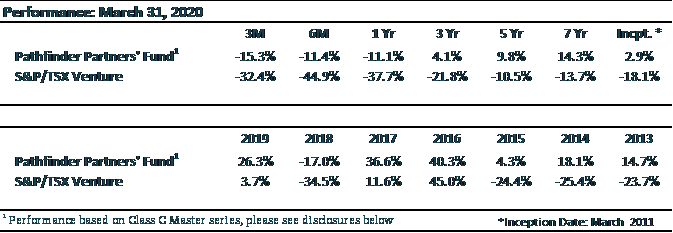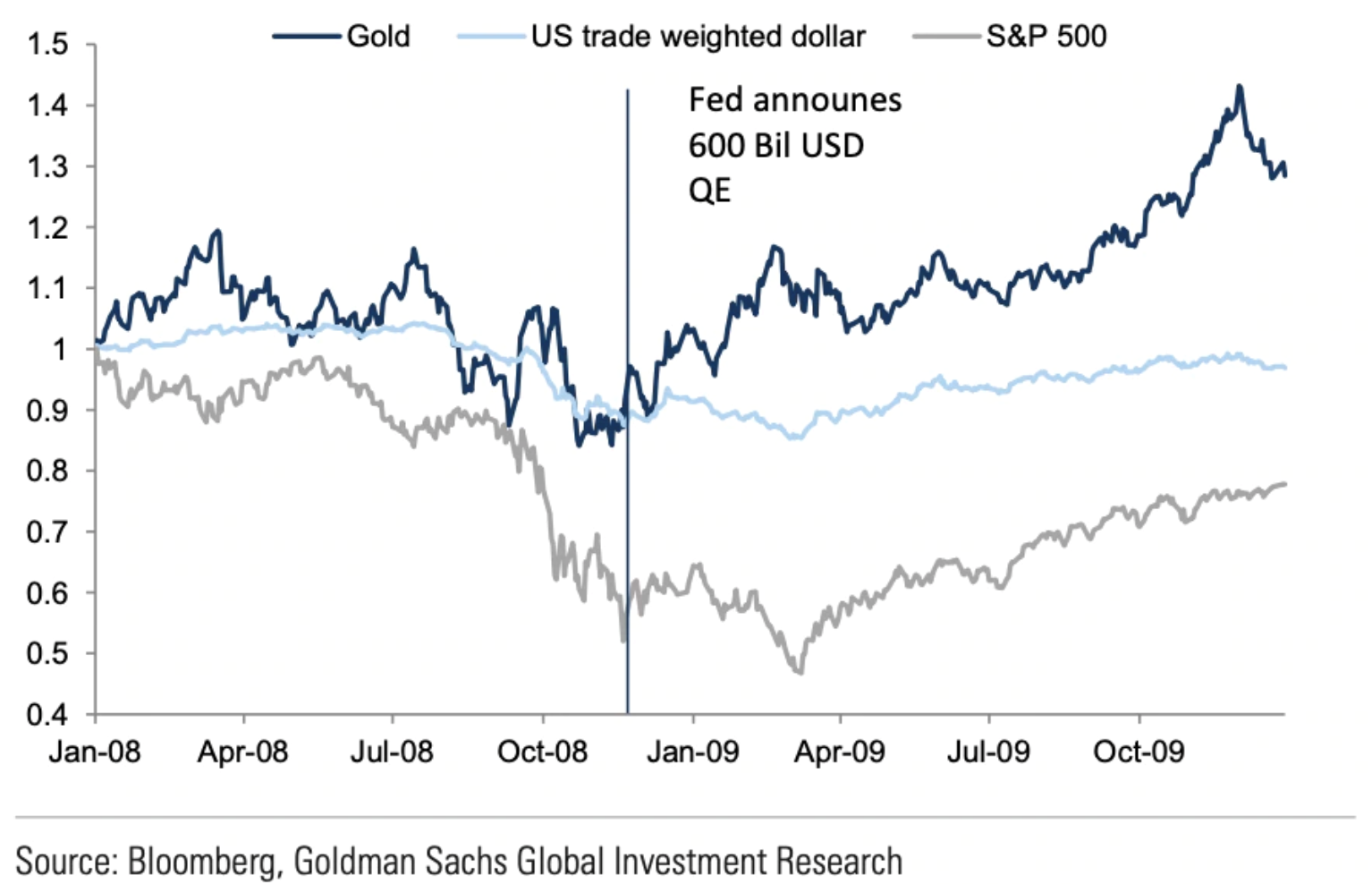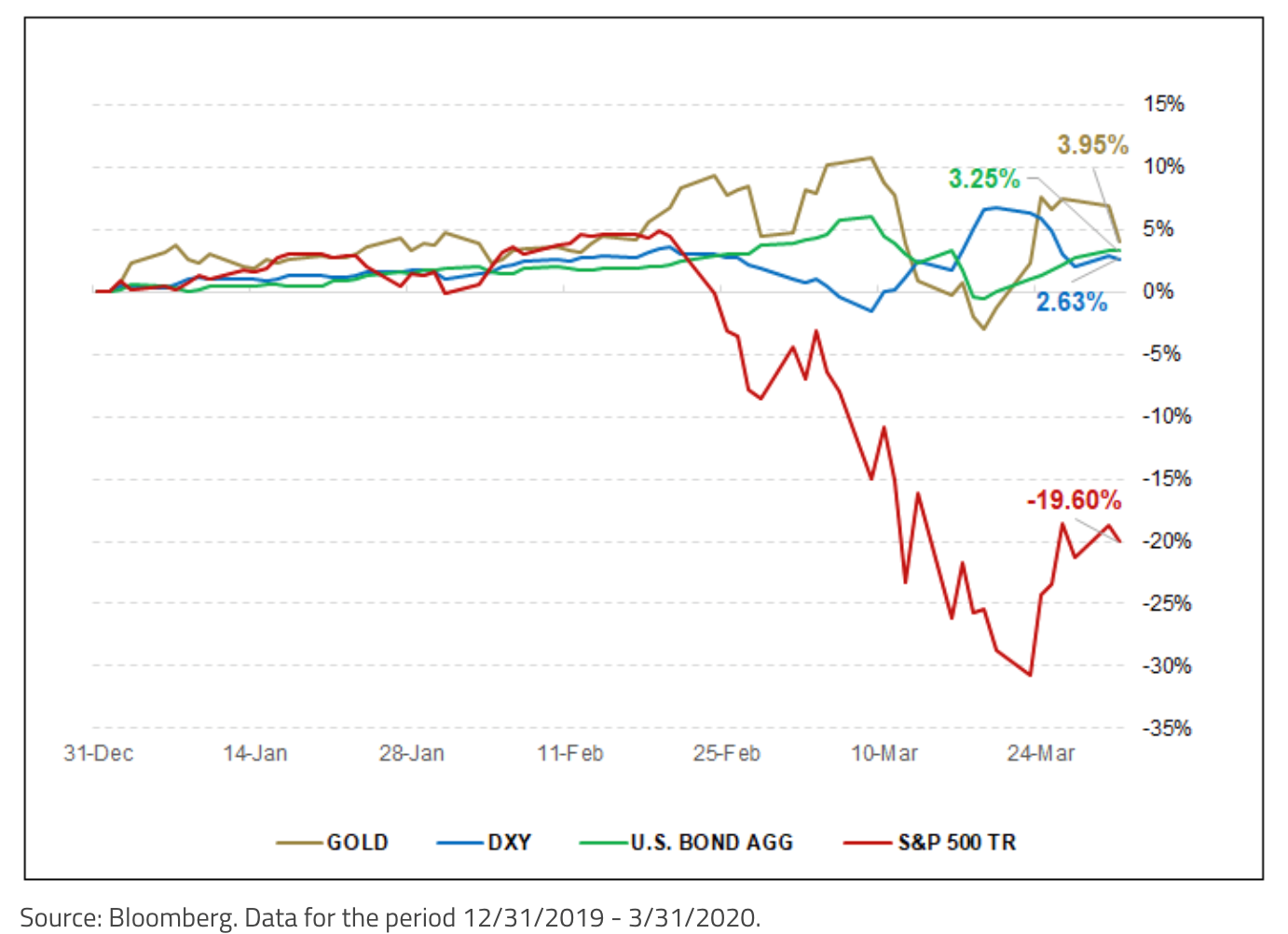Pathfinder Small Cap Quarterly Report
March 31, 2020
The Pathfinder Small Cap mandates invest in high-torque, early-stage companies that have the potential to generate superior returns.
Pathfinder Partners’ Fund
The Partners’ Fund had a net decline of 15.3% in the first quarter of 2020. This compares to the TSX Venture Exchange which declined 32.4%. Our annualized 7-year return is 14.3% compared to the TSX Venture Exchange’s return of -13.7% per year over the same period. The table below provides a performance summary:

Losses were spread across the whole portfolio due to COVID-19. There were no notable contributors and our largest holdings contributed to most of the portfolio decline. At the end of the quarter, our top four holdings comprised approximately 32% of the fund. Yet despite their share price declines, the defensive nature of these companies shone through and their outlook is robust in our opinion. Even amidst this global pandemic, our assessment of the intrinsic value of these business remains largely unchanged, leading us to have a bullish outlook for the portfolio despite many uncertainties with respect to COVID-19, the global economy, and the outlook for large-cap stocks.
Our current top four holdings are Currency Exchange International (TSX:CXI), Terra Firma Capital (TSXv:TII), Altius Minerals (TSX:ALS), and Vitalhub Corp (TSXv:VHI). Forgive us for getting into the weeds with details on our main holdings, but we think it is important to convey the defensive nature of these companies which we hope will provide downside protection and ultimately drives our bullish outlook on the portfolio for the remainder of the year.
Currency Exchange International (TSX:CXI)
As its name suggests, Currency Exchange International provides a variety of foreign exchange and related products to a wide range of customers including financial institutions, money service businesses and other commercial clients. Much of this business is tied to travel activity; people need foreign exchange solutions when they travel to different countries. With reduced travel activity negatively affecting transaction volumes and revenue, why are we optimistic about our prospects for holding CXI?
First, CXI has a robust balance sheet and trades at an attractive valuation. At the time of writing, they have an $80 million market cap and $100 million in cash on their balance sheet. CXI fits the definition of a true net-net stock, a profitable company that is valued at its net working capital. This combination of a strong balance sheet and low valuation creates an investment option with very little downside risk; in our opinion, we are getting the operating business for free!
Second, as the lack of travel due to COVID puts pressure on foreign exchange companies, CXI’s competitors are struggling which will allow CXI to emerge from this crisis with a stronger competitive position and greater market share. Their main business line, wholesale banknotes for FX, is a concentrated industry in North America with four companies comprising about 90% of the market (CXI and three competitors). One of these three major competitors (Travelex) entered this crisis with a leveraged balance sheet and is in extreme distress, having recently hired an advisor to prepare for a potential insolvency. The stock of the parent company (Finablr) is halted and down over 90% for the year. Travelex’s customers are likely to leave for greener pastures, with some of them signing up with CXI. When this crisis ends, CXI will emerge with greater market share and fewer competitors – a recipe for superior returns. Likewise, on the FX Payments side of their business, a similar story has emerged with poorly capitalized competitors such as EncoreFX filing for bankruptcy.
Terra Firma Capital (TSXv:TII)
Terra Firma is a lender to home builders and is another example of a company trading at well below its liquidation value. This provides strong downside protection to our shares and creates a compelling risk/reward situation. The company ended the quarter with a share price of $4.50 per share, less than half of its reported book value of $9.50 per share. What makes Terra Firma special, other than its high ownership and strong management team (table stakes for us to own the company), is that the company lends money with little to no leverage.
A typical lender runs its business on a leverage of ten times or more. What ten times leverage means is if the company has a capital base (equity) of $100 million, for example, it would have $1 billion worth of loans outstanding. The company would take on $900 million in a combination of debt or deposits from savers in order to lend out. Leverage, or the strategy of using borrowed money, is a way to amplify both your return and your risk. In the above example, a loan loss of only 5% would wipe out half of the company’s capital that is available to owners!
Terra Firma, on the other hand, uses hardly any leverage to make its loans. Instead, they syndicate, or sell, a portion of their loans to third party investors and earn fees and an interest rate spread on the loan. If the loan defaults, Terra Firma is not responsible for the losses on syndicated loans. For this reason, we view Terra Firma as having dramatically less risk than your typical lender. This supports our theory that Terra Firma is trading at well below liquidation value, even in a crisis. We have stress tested the company’s loans and believe that even if the housing market crashed to the same degree as the Financial Crisis of 2008, Terra Firma would experience a maximum loss of 10-20% while many other lenders would be wiped out. Our analysis suggests that we would still be in a strong position to realize profit on our investment even in such a scenario.
Altius Minerals (TSX:ALS)
Altius Minerals is a new holding for the Partners’ Fund and has quickly grown to be our third largest holding, with over 95% of our position having been purchased in March 2020. The company has a strong balance sheet, excellent management, and a deeply discounted valuation. Typically, such high-quality companies rarely trade at bargain-basement prices, but we were able to take advantage of the market dislocation to initiate a core position in Altius at very attractive prices.
We view Altius as a highly defensive stock due to its diverse portfolio of royalties on 15 different mines. A royalty is higher in the capital structure and less risky than equity ownership; it entitles the holder to a percentage of the revenue that an operation generates as opposed to its profits. In this way, a royalty captures the benefit of commodity price increases, production increases and new discoveries without incurring any operating, exploration, or capital costs.
Altius’ flagship asset is a royalty on a collection of the highest quality group of mines in the world, in our opinion – Saskatchewan’s potash mines operated by Nutrien and Mosaic. Canada is the world’s largest potash producer, accounting for 33% of the world’s production. Potash is the common name given to a group of minerals containing potassium that are typically used in agriculture to help plants grow, with 90-95% of potash being used in agriculture as fertilizer. It is an essential nutrient for plant growth and plays a central role in the global food supply chain. We think of these mines as high quality because of their mission-critical nature role in feeding the world and the lack of viable alternative production sources if they were to shut down. We expect this royalty to provide Altius with a steadily growing (albeit lumpy) cash flow stream for the next 100+ years – a cornerstone cash flow stream on which management can continue to grow the company.
Vitalhub Corp
Vitalhub is a Healthcare IT provider that has two main lines of business. They provide Electronic Health Record (EHR) solutions to niche markets such as Mental Health, Long Term Care, Community Health and Home Health. They also provide patient flow and software solutions to Hospitals. They key to Vitalhub is that they are a software company servicing the healthcare sector and most of their revenue is recurring, which limits the impact that COVID-19 will have on their business. In fact, in the last month they have developed two new products relating to the COVID-19, a patient flow solution for hospitals and an electronic screening tool for long term care. Vitalhub is a growth by acquisition company and they recently completed a $15 million financing, meaning at at the end of the quarter almost half of their market cap was in cash. We believe that in the current environment the price they pay to acquire new companies will be lowered, creating additional value for current shareholders.
To summarize, based on the fundamentals of our main portfolio holdings, we are confident about the positioning and outlook of the Partners’ Fund. The current market environment is dynamic and future developments with respect to COVID-19 and the global economy are almost impossible to predict, in our opinion, due the exceedingly wide range of potential outcomes. That being said, we have faith in management’s ability and balance sheets of our holdings to navigate through these difficult times. The vast majority of our purchases during the quarter were made in the above four companies as we shifted the portfolio to be more concentrated in our top holdings. Thank you for your enduring trust and support!
Pathfinder Resource Fund
During the quarter, the Resource fund declined by 17.6%. This compares to the benchmark decline of 29.9%. Since inception (July 16, 2018), the Resource Fund has returned -8.5% annualized versus the benchmark annualized return of -17.3% per year. The benchmark consists of 75% of the daily return of the S&P/TSX Capped Materials Index and 25% of the daily return of the S&P/TSX Capped Energy Index.

During the quarter, Highgold Mining Inc (TSXv:HIGH) was our largest positive contributors, adding 2.9% to gross returns. Our largest negative contributor was Altius Minerals Inc (TSX:ALS) (discussed above) which decreased gross returns by 3.5% for the quarter.
Markets were highly volatile in March due mainly to the global pandemic but also in part to the collapse of OPEC resulting in an oil price war. We saw the U.S. Federal Reserve reduce interest rates to zero and impose unlimited quantitative easing to stop the downturn. With this stimulus package now in place, we feel the conditions are favourable for gold to outperform as it did in 2008 when it rallied to $1,900/oz on the back of reduced liquidity stress (Figure 1).
Figure 1: Gold’s performance compared to the US dollar and S&P 500 in 2008 after the introduction of QE

With all the instability in the market, we took the opportunity to add to our high conviction positions and focused on upgrading the quality our of development portfolio at reasonable prices. We were also very actively trading in an effort to capitalize on the wild swings in share prices. Recall, the portfolio is well positioned with 60% invested in precious metals focused companies, 30% in base metals focused companies, and 10% in special situations. Part of our strategy when liquidity strains emerged was to initiate a hedge and trim some of our core positions before the pullback allowing us to add new positions and buy back current positions at attractive prices to maximize gains during a recovery.
We maintain our supply driven thesis for the case of gold (dwindling reserves/grades, and lack of quality projects) but we would also like to highlight the macro view. Gold is currently trading at a seven-year high underpinned by; zero benchmark interest rates, the growing federal debt, looming economic effects of COVID-19, and the growing concern of the US dollar being displaced as the world’s funding currency. As a result, gold is typically seen as a hedge against inflation and inversely related to the US dollar. As we discussed in previous quarters, the outlook for commodities has been especially compelling and even more so now due to the factors mentioned above and thus, we are seeing a “a flight to safety” into commodities. (Figure 2).
Figure 2: YTD gold performance (+3.95%) compared to Stocks, Bonds and the Dollar

National Instrument 31-103 requires registered firms to disclose information that a reasonable investor would expect to know, including any material conflicts with the firm or its representatives. Doug Johnson and/or Pathfinder Asset Management Limited are an insider of companies periodically mentioned in this report. Please visit www.paml.ca for disclosures.
* All returns are time weighted and net of investment management fees. Returns from the Pathfinder Partners’ Fund are presented based on the Class C Master series except prior to its inception in July 2011 when the Class A Master series was used. Inception returns include the 10 months from inception in March 2011. Returns greater than one year are annualized. Returns from the Pathfinder Resource Fund are presented based on the Class C Master series since its inception in July 16, 2018. The S&P/TSX Venture Composite Index (C$), the S&P/TSX Venture Composite Index, the S&P/TSX Capped Materials Index and the S&P/TSX Capped Energy Index provide general information and should not be interpreted as a benchmark for your own portfolio return. Further details of the Partners’ Fund are available on request.
Pathfinder Asset Management Limited (PAML) and its affiliates may collectively beneficially own in excess of 10% of one or more classes of the issued and outstanding equity securities mentioned in this newsletter. This publication is intended only to convey information. It is not to be construed as an investment guide or as an offer or solicitation of an offer to buy or sell any of the securities mentioned in it. The author is an employee of PAML, but the data selection, analysis and views expressed herein are solely those of the author and not those of PAML. The author has taken all usual and reasonable precautions to determine that the information contained in this publication has been obtained from sources believed to be reliable and that the procedures used to summarize and analyze such information are based on approved practices and principles in the investment industry. However, the market forces underlying investment value are subject to sudden and dramatic changes and data availability varies from one moment to the next. Consequently, neither the author nor PAML can make any warranty as to the accuracy or completeness of information, analysis or views contained in this publication or their usefulness or suitability in any particular circumstance. You should not undertake any investment or portfolio assessment or other transaction on the basis of this publication, but should first consult your portfolio manager, who can assess all relevant particulars of any proposed investment or transaction. PAML and the author accept no liability of any kind whatsoever or any damages or losses incurred by you as a result of reliance upon or use of this publication.